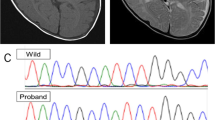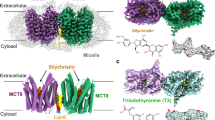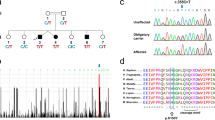Abstract
Mutations in the thyroid monocarboxylate transporter 8 gene (MCT8/SLC16A2) have been reported to result in X-linked mental retardation (XLMR) in patients with clinical features of the Allan–Herndon–Dudley syndrome (AHDS). We performed MCT8 mutation analysis including 13 XLMR families with LOD scores >2.0, 401 male MR sibships and 47 sporadic male patients with AHDS-like clinical features. One nonsense mutation (c.629insA) and two missense changes (c.1A>T and c.1673G>A) were identified. Consistent with previous reports on MCT8 missense changes, the patient with c.1673G>A showed elevated serum T3 level. The c.1A>T change in another patient affects a putative translation start codon, but the same change was present in his healthy brother. In addition normal serum T3 levels were present, suggesting that the c.1A>T (NM_006517) variation is not responsible for the MR phenotype but indicates that MCT8 translation likely starts with a methionine at position p.75. Moreover, we characterized a de novo translocation t(X;9)(q13.2;p24) in a female patient with full blown AHDS clinical features including elevated serum T3 levels. The MCT8 gene was disrupted at the X-breakpoint. A complete loss of MCT8 expression was observed in a fibroblast cell-line derived from this patient because of unfavorable nonrandom X-inactivation. Taken together, these data indicate that MCT8 mutations are not common in non-AHDS MR patients yet they support that elevated serum T3 levels can be indicative for AHDS and that AHDS clinical features can be present in female MCT8 mutation carriers whenever there is unfavorable nonrandom X-inactivation.
Similar content being viewed by others
Log in or create a free account to read this content
Gain free access to this article, as well as selected content from this journal and more on nature.com
or
Accession codes
References
Friesema EC, Grueters A, Biebermann H et al: Association between mutations in a thyroid hormone transporter and severe X-linked psychomotor retardation. Lancet 2004; 364: 1435–1437.
Brockmann K, Dumitrescu AM, Best TT, Hanefeld F, Refetoff S : X-linked paroxysmal dyskinesia and severe global retardation caused by defective MCT8 gene. J Neurol 2005; 252: 663–666.
Holden KR, Zuniga OF, May MM et al: X-linked MCT8 gene mutations: characterization of the pediatric neurologic phenotype. J Child Neurol 2005; 20: 852–857.
Schwartz CE, May MM, Carpenter NJ et al: Allan–Herndon–Dudley syndrome and the monocarboxylate transporter 8 (MCT8) gene. Am J Hum Genet 2005; 77: 41–53.
Maranduba CM, Friesema EC, Kok F et al: Decreased cellular uptake and metabolism in Allan–Herndon–Dudley syndrome (AHDS) due to a novel mutation in the MCT8 thyroid hormone transporter. J Med Genet 2006; 43: 457–460.
Herzovich V, Vaiani E, Marino R et al: Unexpected peripheral markers of thyroid function in a patient with a novel mutation of the MCT8 thyroid hormone transporter gene. Horm Res 2007; 67: 1–6.
Schwartz CE, Stevenson RE : The MCT8 thyroid hormone transporter and Allan–Herndon–Dudley syndrome. Best Pract Res Clin Endocrinol Metab 2007; 21: 307–321.
Friesema EC, Jansen J, Heuer H, Trajkovic M, Bauer K, Visser TJ : Mechanisms of disease: psychomotor retardation and high T3 levels caused by mutations in monocarboxylate transporter 8. Nat Clin Pract Endocrinol Metab 2006; 2: 512–523.
de Brouwer AP, Yntema HG, Kleefstra T et al: Mutation frequencies of X-linked mental retardation genes in families from the EuroMRX consortium. Hum Mutat 2007; 28: 207–208.
Jensen LR, Lenzner S, Moser B et al: X-linked mental retardation: a comprehensive molecular screen of 47 candidate genes from a 7.4 Mb interval in Xp11. Eur J Hum Genet 2007; 15: 68–75.
Allen RC, Zoghbi HY, Moseley AB, Rosenblatt HM, Belmont JW : Methylation of HpaII and HhaI sites near the polymorphic CAG repeat in the human androgen-receptor gene correlates with X chromosome inactivation. Am J Hum Genet 1992; 51: 1229–1239.
Garcia-Heras J, Martin JA, Witchel SF, Scacheri P : De novo der(X)t(X;10)(q26;q21) with features of distal trisomy 10q: case report of paternal origin identified by late replication with BrdU and the human androgen receptor assay (HAR). J Med Genet 1997; 34: 242–245.
Coonen E, Dumoulin JC, Dreesen JC, Bras M, Evers JL, Geraedts JP : Clinical application of FISH for sex determination of embryos in preimplantation diagnosis of X-linked diseases. J Assist Reprod Genet 1996; 13: 133–136.
Robledo R, Melis P, Laficara F et al: Further linkage evidence for localization of mutational sites for nonsyndromic types of X-linked mental retardation at the pericentromeric region. Am J Med Genet 1996; 64: 107–112.
Donnelly AJ, Partington MW, Ryan AK, Mulley JC : Regional localisation of two non-specific X-linked mental retardation genes (MRX30 and MRX31). Am J Med Genet 1996; 64: 113–120.
Yntema HG, van den Halm B, Knoers NV et al: X-linked mental retardation: evidence for a recent mutation in a five-generation family (MRX65) linked to the pericentromeric region. Am J Med Genet 1999; 85: 305–308.
Raynaud M, Moizard MP, Dessay B et al: Systematic analysis of X-inactivation in 19 XLMR families: extremely skewed profiles in carriers in three families. Eur J Hum Genet 2000; 8: 253–258.
Sunyaev S, Ramensky V, Koch I, Lathe III W, Kondrashov AS, Bork P : Prediction of deleterious human alleles. Hum Mol Genet 2001; 10: 591–597.
Friesema EC, Ganguly S, Abdalla A, Manning Fox JE, Halestrap AP, Visser TJ : Identification of monocarboxylate transporter 8 as a specific thyroid hormone transporter. J Biol Chem 2003; 278: 40128–40135.
Lafreniere RG, Carrel L, Willard HF : A novel transmembrane transporter encoded by the XPCT gene in Xq13.2. Hum Mol Genet 1994; 3: 1133–1139.
Dumitrescu AM, Liao XH, Best TB, Brockmann K, Refetoff S : A novel syndrome combining thyroid and neurological abnormalities is associated with mutations in a monocarboxylate transporter gene. Am J Hum Genet 2004; 74: 168–175.
Acknowledgements
We thank Mieke Alofs (University Hospital Maastricht) and Marleen Willems (University Hospital Leuven) for their expert assistance on culturing fibroblasts, Erik van Lierop, Bertien Hollanders, Lucy Amory and Demis Tserpelis (University Hospital Maastricht) for cytogenetic and molecular X-inactivation studies. We are grateful to Bettina Moser, Melanie Wendehack and Marianne Schlicht for technical assistance in the mutation screening study. This work was supported by the Research Grant 016.066.017 of the Dutch NWO/ZonMW VENI fund, The Netherlands, Research Grant G-0229-01 of the Fund for Scientific Research-Flanders (FWO-Vlaanderen), Belgium, by the Deutsche Forschungsgemeinschaft (SFB 577) and the EURO-MRX project (part of the European ‘Quality of Life and Management of Living Resources Programme’ QLG3-CT-2002-01810).
Author information
Authors and Affiliations
Corresponding authors
Additional information
Supplementary Information accompanies the paper on European Journal of Human Genetics website (http://www.nature.com/ejhg)
Supplementary information
Rights and permissions
About this article
Cite this article
Frints, S., Lenzner, S., Bauters, M. et al. MCT8 mutation analysis and identification of the first female with Allan–Herndon–Dudley syndrome due to loss of MCT8 expression. Eur J Hum Genet 16, 1029–1037 (2008). https://doi.org/10.1038/ejhg.2008.66
Received:
Revised:
Accepted:
Published:
Issue date:
DOI: https://doi.org/10.1038/ejhg.2008.66
Keywords
This article is cited by
-
First female with Allan-Herndon-Dudley syndrome and partial deletion of X-inactivation center
neurogenetics (2021)
-
X-exome sequencing in Finnish families with Intellectual Disability - four novel mutations and two novel syndromic phenotypes
Orphanet Journal of Rare Diseases (2014)
-
Manifestazioni cliniche delle mutazioni del trasportatore degli ormoni tiroidei MCT8
L'Endocrinologo (2013)
-
Endocrine manifestations related to inherited metabolic diseases in adults
Orphanet Journal of Rare Diseases (2012)
-
Insights into molecular properties of the human monocarboxylate transporter 8 by combining functional with structural information
Thyroid Research (2011)



